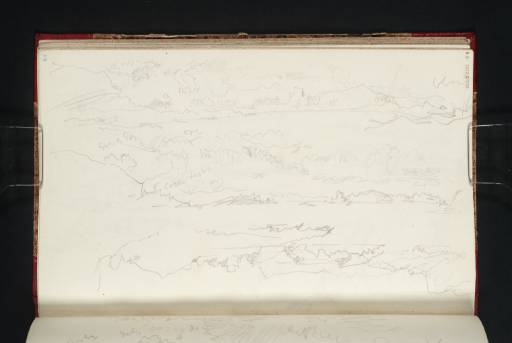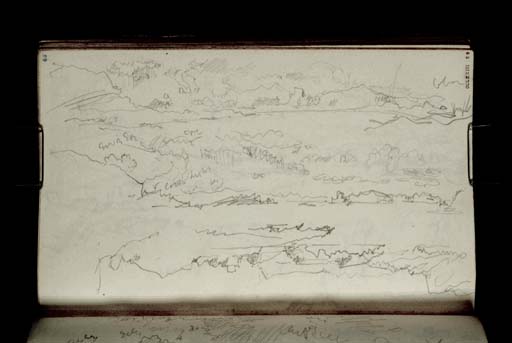J.M.W. Turner
>
1830-35 Annual tourist
>
Scotland 1831
>
Staffa Sketchbook
>
Artwork
Joseph Mallord William Turner Oban Bay and Dunollie Castle from Gallanach Road 1831
Image 1 of 2
Joseph Mallord William Turner,
Oban Bay and Dunollie Castle from Gallanach Road
1831
Joseph Mallord William Turner 1775–1851
Folio 60 Recto:
Oban Bay and Dunollie Castle from Gallanach Road 1831
D26858
Turner Bequest CCLXXIII 60
Turner Bequest CCLXXIII 60
Pencil on white wove paper, 116 x 186 mm
Inscribed in pencil by Turner ‘cold’ | ‘g’ ‘Red’ above the top sketch to the left, ‘Oban’ above the top sketch to the right, ?‘Growing gold’ ?‘col’ | ‘v cold lights’ above the middle sketch to the left, ‘Red’ above the middle sketch centre
Inscribed in blue ink by John Ruskin ‘60’ top left running vertically
Stamped in black ‘CCLXXIII 60’ top right running vertically
Inscribed in pencil by Turner ‘cold’ | ‘g’ ‘Red’ above the top sketch to the left, ‘Oban’ above the top sketch to the right, ?‘Growing gold’ ?‘col’ | ‘v cold lights’ above the middle sketch to the left, ‘Red’ above the middle sketch centre
Inscribed in blue ink by John Ruskin ‘60’ top left running vertically
Stamped in black ‘CCLXXIII 60’ top right running vertically
Accepted by the nation as part of the Turner Bequest 1856
References
1909
A.J. Finberg, A Complete Inventory of the Drawings of the Turner Bequest, London 1909, vol.II, p.877, CCLXXIII 60, as ‘Mountains and clouds.’.
1991
David Wallace-Hadrill and Janet Carolan, ‘Turner in Argyll in 1831: Inveraray to Oban’, Turner Studies, vol. 11, no.1, Summer 1991, pp.25, 28.
These three sketches were, according to David Wallace-Hadrill and Janet Carolan,1 made from the Gallanach Road that runs south along the coast from Oban. We look north across the Sound of Kerrera with Oban Bay on the left, Dunollie Castle at the centre (see folio 95; D26928 for references) and the island of Kerrera at the left of the sketch. In the top two of these sketches, and in another on folio 59 verso (D26857), Turner has paid particular attention to the sky, using a variety of sketching techniques and inscriptions to note down the appearance and effects.
With just outlines, Turner has recorded various details about the clouds and weather in these top two sketches. For example, in the second sketch only the tops of the clouds are drawn, indicating that they are lit from above. The clouds at the centre of the top sketch have a broken outline, suggesting that these have less defined masses. Low, wispy, broken cloud forms at the right of the second sketch are suggested with overlapping looping lines. Other clouds, or areas of dark cloud, are suggested by scribbled or hatched parallel lines: the closer together the lines, the darker the sky.
Turner uses inscriptions to note the different areas of colour in the sky. In the top sketch it is therefore ‘red’ towards the left, with what is probably meant to be a grey patch (‘g’) beneath to the left and a mass of ‘cold’-coloured cloud above.2 In the second sketch the ‘Red’ areas of the sky have shifted to the right above Dunollie castle and at the far right. Turner has noted ‘v[ery] cold lights’ low in the sky towards the left, and what may read ‘Growing gold’ at the left. These notes indicate a sunrise or sunset scene.
The sky is even more dramatic in the associated sketch on folio 59 verso, and on folio 60 verso (D26859), another view from Gallanach, Turner referred to the artist ‘Gaspard’ Dughet, suggesting that something about the sky or the light reminded him of the French master (1615–75).
The sketch at the bottom of the present page does not contain any details in the sky, or colour notes – perhaps because there was no space left on the page. Instead Turner used a heavily drawn jagged outline to suggest the rocky texture of the landscape.
Thomas Ardill
February 2010
How to cite
Thomas Ardill, ‘Oban Bay and Dunollie Castle from Gallanach Road 1831 by Joseph Mallord William Turner’, catalogue entry, February 2010, in David Blayney Brown (ed.), J.M.W. Turner: Sketchbooks, Drawings and Watercolours, Tate Research Publication, December 2012, https://www


